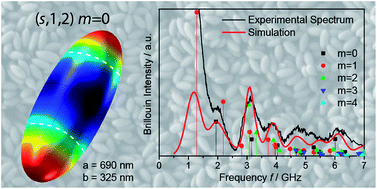Elongated polystyrene spheres as resonant building blocks in anisotropic colloidal crystals†
Abstract
Colloidal crystals have gained increasing importance due to their fascinating ability to mold the flow of light and sound (heat). The characteristics of these ordered assemblies of particles are strongly determined by the respective building blocks, which require complete understanding of their physical properties. In this study the mechanical properties of stretched polystyrene colloids (spheroids) are addressed. The non-invasive technique of Brillouin light scattering captures the vibrational spectra at hypersonic (GHz) frequencies. Resolved eigenmodes are considered fingerprints of the particles' shape, size and composing materials. A single particle model is used to simulate the experimental data by calculation of all active modes and subsequent evaluation of their contribution to the spectrum. Compared to spheres (high symmetry) more modes contribute to the spectra that limit the resolution at very high frequencies, due to the lifted mode degeneracy. Knowing the nature of the principal modes of spheroids is a precondition to understand the phononic dispersion in the respective colloidal crystals, in particular those responsible for anticrossing interactions with the effective medium acoustic phonon.

- This article is part of the themed collection: Directed self-assembly

 Please wait while we load your content...
Please wait while we load your content...